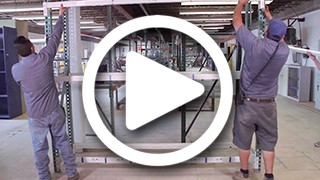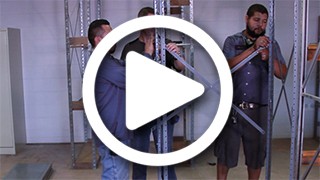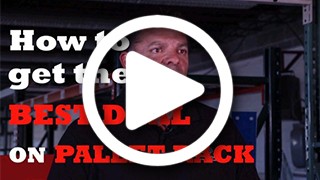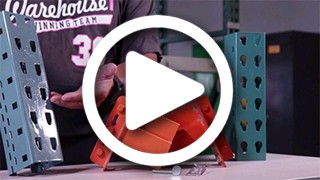How to Stack a Pallet in a Warehouse & Tips to Improve
Strong and versatile, pallets are at the center of any successful warehouse operation. They can be stacked on top of one another to optimize space and reduce shipping expenses.
Unfortunately, the pallet stacking process isn't as simple as it may seem. Rather, this could be one of the most dangerous operations in your warehouse. Both products and workers can be harmed if stacks tip over. Proper stacking maintains OSHA compliance while safeguarding the hardworking employees who keep your facility running efficiently.
Thankfully, the most common stacking dangers can often be prevented or mitigated. To help, we've compiled an easy-to-follow guide on how to stack a pallet.
4 Steps to Properly Stacking a Pallet
Pallet stacking is a comprehensive process that begins long before any pallets or products are actually moved. While this procedure will look a bit different from one facility to the next, it will ideally involve these key steps:
1. Inspect, Organize, And Plan
Plan ahead to ensure that the types of pallets and products are suited to the storage or transport goals at hand. Each situation will call for a different stacking pattern, but you'll probably use one of these main strategies:
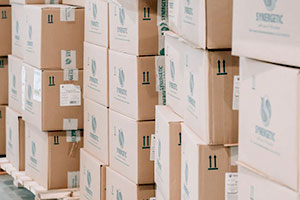 Columnar. Strong and effective, this approach aligns the corners of the upper and lower cases. Unfortunately, columns can be prone to toppling, so this solution is not always advisable.
Columnar. Strong and effective, this approach aligns the corners of the upper and lower cases. Unfortunately, columns can be prone to toppling, so this solution is not always advisable.
 Interlocked. If stability is the main goal, an interlocked method may be preferable. Although not quite as strong as columnar stacking, interlocked pallets are less likely to fall.
Interlocked. If stability is the main goal, an interlocked method may be preferable. Although not quite as strong as columnar stacking, interlocked pallets are less likely to fall.
Typically, low-weight items are better suited to columnar solutions, while heavier objects (such as canned goods) may require interlocking.
2. Start With the Heaviest Items
Whether you ultimately opt for columnar or interlocked stacking, the heaviest items should always be placed near the bottom of the stack. This should promote a lower center of gravity to keep the entire load as stable as possible.
From there, lower-weight pallets can be added as necessary. With each pallet, confirm that the products are lined up to the edge — but without overhang. This will help you make the most of the pallet's horizontal space without compromising stability. The goal is for the pallet to take the brunt of any impact, rather than the items themselves.
3. Strap Everything Down
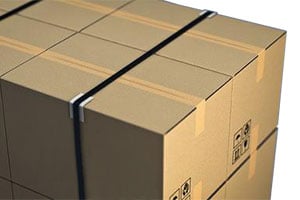 Once products are loaded on the pallet, it's time to strap them down. This binds the items to the pallet and reduces the likelihood of products falling off. There are many approaches available, but ratchet straps are often the most effective. Two separate straps should be used, as should edge protectors to keep the straps from damaging the items they're supposed to safeguard.
Once products are loaded on the pallet, it's time to strap them down. This binds the items to the pallet and reduces the likelihood of products falling off. There are many approaches available, but ratchet straps are often the most effective. Two separate straps should be used, as should edge protectors to keep the straps from damaging the items they're supposed to safeguard.
4. Use Stretch Wrap
Stretch wrap provides yet another boost to stability. This should be the final step, only completed after all items have been strapped down. To limit physical strain, elevate the load and place the pallet at a slight angle.
Focus on the base before working your way up. Don't skimp on material; layers should overlap with preceding layers. After reaching the top, test the stability of the pallet before determining whether additional plastic wrap is required.
Tips To Improve Pallet Stacking in Your Warehouse
While the basics highlighted above can quickly improve pallet stacking processes, additional suggestions can provide yet another boost. Follow these tips to make pallet stacking even safer and more efficient:
Don't Use Damaged Pallets or Boxes in Your Stack
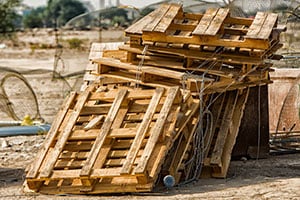 It may seem obvious, but it still bears repeating: damaged pallets have no place in your warehouse. Always inspect pallets and boxes before stacking. There should never be any holes, loose boards, or protruding nails present. Nails and splinters are often missed, but this can be dangerous, as they may puncture shrink wrap and limit the stability of the entire load.
It may seem obvious, but it still bears repeating: damaged pallets have no place in your warehouse. Always inspect pallets and boxes before stacking. There should never be any holes, loose boards, or protruding nails present. Nails and splinters are often missed, but this can be dangerous, as they may puncture shrink wrap and limit the stability of the entire load.
Keep Size And Weight Restrictions in Mind
Take a close look at height and weight limits before determining how high to stack pallets. These should never exceed fifteen feet — but depending on the types of products stacked and where they'll be stored or handled, far lower heights may prove necessary.
For weight restrictions, the type of pallet used will be highly influential, as will the actual condition of these pallets. Wooden pallets, for example, may begin with a capacity exceeding 5,000 pounds, but this may reduce with time as the pallets degrade. Capacities tend to be higher for plastic pallets.
Try to Keep Sizes and Weights Consistent
Consistency should be ensured whenever possible. Keep similar items near one another. While it's possible to stack a pallet with items of varying sizes or weights, it will be a lot more difficult to maintain stability as product versatility increases.
Use Proper Lifting Equipment
Workers should not be forced to constantly lift heavy items on their own. Instead of relying on manual labor, look to lifting equipment to get the job done quickly and safely. Essentials include:
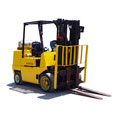 Forklifts. Central to the success of the modern warehouse, the simple forklift is one of the most important tools in any facility. This vehicle has a forked platform, which can be raised or lowered while loaded with pallets.
Forklifts. Central to the success of the modern warehouse, the simple forklift is one of the most important tools in any facility. This vehicle has a forked platform, which can be raised or lowered while loaded with pallets.
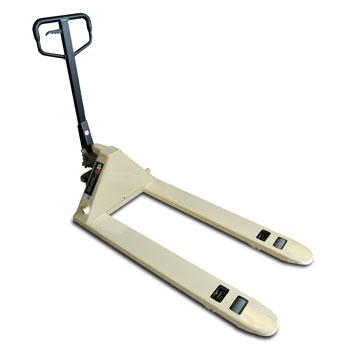 Pallet jacks. Sometimes referred to as pallet trucks, pallet jacks feature wheeled trolleys, with handles or levers that can be pressed down. While most people think of these as manual tools, electric pallet jacks are available.
Pallet jacks. Sometimes referred to as pallet trucks, pallet jacks feature wheeled trolleys, with handles or levers that can be pressed down. While most people think of these as manual tools, electric pallet jacks are available.
Use Technology To Help With Loading and Unloading In Your Warehouse
Many safety concerns that previously placed workers in harm's way are now easy to sidestep. Advanced solutions can dramatically improve employee awareness. Not every enterprise requires the most cutting-edge tech solutions, but a few are all but universally beneficial.
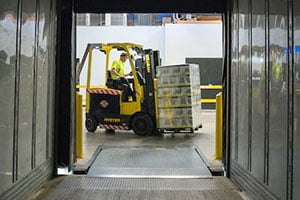 For example: there's no denying the value of the forklift backup camera. Similar to the backup cameras found in most vehicles these days, this safety system provides a clear view of the space behind each forklift. This should let drivers know when they're at risk of colliding with pallet racks or worse, other people. Similarly, laser guides and leveling alarms optimize pallet entry when using forklifts for large loads.
For example: there's no denying the value of the forklift backup camera. Similar to the backup cameras found in most vehicles these days, this safety system provides a clear view of the space behind each forklift. This should let drivers know when they're at risk of colliding with pallet racks or worse, other people. Similarly, laser guides and leveling alarms optimize pallet entry when using forklifts for large loads.
Make Sure Your Warehouse Is Set Up to Handle Loaded Pallets
No matter how your pallets are stacked, they will remain vulnerable if your warehouse is not equipped to handle them once loaded.
Your setup could include:
 Wire deck. Wire decks are an important safety feature in your warehouse and can catch dropped cases that may fall from pallets.
Wire deck. Wire decks are an important safety feature in your warehouse and can catch dropped cases that may fall from pallets. - Pallet supports. Critical for maintaining structural integrity for the heaviest loads, support bars are especially useful when pallet racks aren't equipped with wire decking. Sometimes referred to as crossbars, these can prevent pallets from falling through.
- Backstop beams. Acting as a guide when placing pallets, backstop beams stop loaded pallets from falling off the back of the rack.
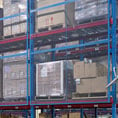 Rack safety nets and cages. Forming a vertical barrier, rack safety nets and cages help keep both pallets and loose boxes contained. In the event that boxes become unstable, safety nets prevent them from hitting warehouse workers below.
Rack safety nets and cages. Forming a vertical barrier, rack safety nets and cages help keep both pallets and loose boxes contained. In the event that boxes become unstable, safety nets prevent them from hitting warehouse workers below.
Provide Training
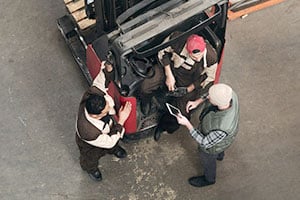 Your facility could be stocked with all the best equipment, but pallet problems will still occur if employees are not thoroughly trained in proper pallet stacking and loading and unloading pallet racks. This is essential for initial training, of course, but frequent reminders will be needed as well.
Your facility could be stocked with all the best equipment, but pallet problems will still occur if employees are not thoroughly trained in proper pallet stacking and loading and unloading pallet racks. This is essential for initial training, of course, but frequent reminders will be needed as well.
Many businesses focus on training forklift drivers, but this effort should extend to all other types of warehouse workers. Preferred practices for loading and unloading, in particular, must be clearly outlined, as should the proper use of various types of pallet jacks.
Efficient and Safe Pallet Stacking With Warehouse1
Consistency with pallet stacking can make a world of difference for your business, influencing everything from safety to customer satisfaction. If this is an area of weakness, it needs to be addressed promptly.
Our team at Warehouse1 can help you optimize your warehouse design and obtain the proper equipment to ensure proper pallet stacking. Contact us today to learn more.
